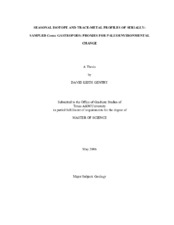| dc.contributor.advisor | Grossman, Ethan L. | |
| dc.creator | Gentry, David Keith | |
| dc.date.accessioned | 2006-08-16T19:07:12Z | |
| dc.date.available | 2006-08-16T19:07:12Z | |
| dc.date.created | 2003-05 | |
| dc.date.issued | 2006-08-16 | |
| dc.identifier.uri | https://hdl.handle.net/1969.1/3871 | |
| dc.description.abstract | We test the fidelity of shallow-water gastropod skeletons as multi-proxy archives of seasonal paleo-environmental change by performing isotopic and trace-metal analyses on specimens of Conus ermineus from the Gulf of Mexico. Four adult specimens were collected from Stetson Bank in the Flower Garden Banks National Marine Sanctuary during the summer of 2002. Shell samples were milled along axes of growth to produce time-series profiles spanning up to eight years. We corrected the profiles for growth rate effects and compared the tuned results with in situ temperature and salinity records at the reef surface and temperature profiles from nearby surface buoys. Examination of sample densities in δ18O cycles shows that shell growth is faster during summers and slower during winters. Tuning the profiles versus time yields δ18O values that co-vary closely with seasonal temperatures to a high degree of coherency (R2 = 0.84). The δ13C profiles show cyclic variation modified by ontogenetic decreases in δ13C. These ontogenetic trends are attributable to decreasing metabolic efficiency, while seasonal cycles reflect hydrographic changes in the gastropodsÂ’ habitat. Salinity and δ13C of dissolved inorganic carbon show a strong correlation at Stetson Bank (R2 = 0.80), and early summer shell δ13C minima coincide with local salinity minima during times of peak river discharge. The terminations of these δ13C minima occur during annual upcoast reversals of shelf currents in this area. These effects are augmented by summer stratification and productivity minima that further decrease seawater δ13C. Sr/Ca ratios increase through ontogeny, most likely due to decreasing metabolic efficiency. However, seasonal variations in Sr/Ca profiles show strong similarity with δ18O profiles, confirming the temperature dependence of Sr/Ca and minimal influence of salinity on shell δ18O at Stetson Bank. The results of this study show that tuned δ18O and Sr/Ca profiles can be used to reconstruct seasonal paleotemperatures. Carbon isotope profiles and environmental data also demonstrate the utility of Conus δ13C as a proxy for freshwater flux and shelf circulation. | en |
| dc.format.extent | 2154720 bytes | en |
| dc.format.medium | electronic | en |
| dc.format.mimetype | application/pdf | |
| dc.language.iso | en_US | |
| dc.publisher | Texas A&M University | |
| dc.subject | stable isotopes | en |
| dc.subject | oxygen isotopes | en |
| dc.subject | carbon isotopes | en |
| dc.subject | strontium | en |
| dc.subject | calcium | en |
| dc.subject | gastropods | en |
| dc.subject | mollusks | en |
| dc.subject | paleoclimate | en |
| dc.subject | paleoceanography | en |
| dc.title | Seasonal isotope and trace-metal profiles of serially-sampled Conus gastropods: proxies for paleoenvironmental change | en |
| dc.type | Book | en |
| dc.type | Thesis | en |
| thesis.degree.department | Geology and Geophysics | en |
| thesis.degree.discipline | Geology | en |
| thesis.degree.grantor | Texas A&M University | en |
| thesis.degree.name | Master of Science | en |
| thesis.degree.level | Masters | en |
| dc.contributor.committeeMember | Slowey, Niall C. | |
| dc.contributor.committeeMember | Yancey, Thomas E. | |
| dc.type.genre | Electronic Thesis | en |
| dc.type.material | text | en |
| dc.format.digitalOrigin | born digital | en |


